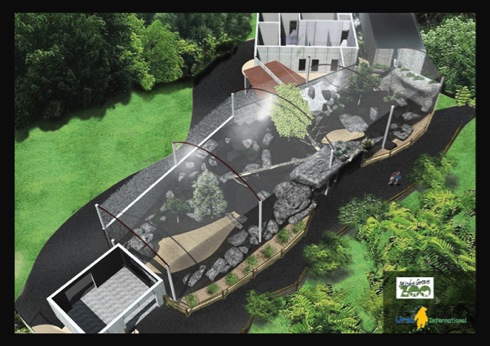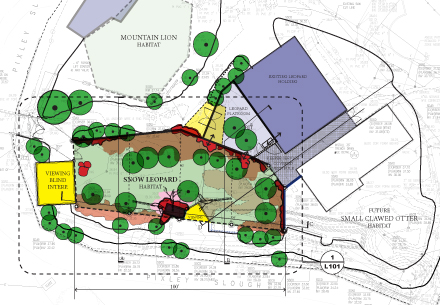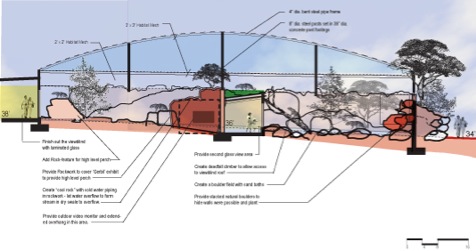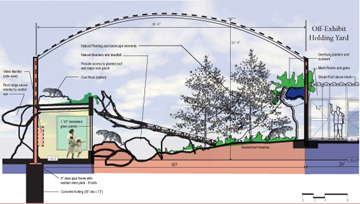Snow Leopard
Micke Grove Zoo, Lodi, CaliforniaSnow Leopard Enclosure, 2013

Aerial Perspective of Snow Leopard Enclosure
The Snow Leopard Exhibit has been many years in the making. Earlier plans were able to build the holding building and the beginnings of the viewing blind as well as many underground utilities. Now is the time to complete the work. A new, more cost effective, plan is now being designed to bring Snow Leopards back to Micke Grove Zoo. This plan builds on the previous one and more importantly, does it more efficiently.
The exhibit is comprised of a large, 3500 sf habitat that is enclosed under stainless steel netting, with two covered, through-glass viewing areas as well as 50 lf of viewing along the path though the netting. There is also a 400 s.f. off-exhibit, outdoor holding area that provides a flexible area for Snow Leopard Management as either additional holding while the exhibit is occupied by Mother and cubs or for secure night holding that expands the area given to the Cats after hours. There is a viewing area associated with the Off-exhibit Area that can be used to give training demonstrations and keeper talks for the visitors as they make their way into the exhibit.
The first glimpse of the Snow Leopards comes once the visitors cross the bridge leaving the Gibbon Exhibit, and they can participate in one of the Public Demonstrations, where they can learn how the Micke Grove Zoo cares for Snow Leopards and what currently is happening with Snow Leopards in the wild. Adjacent to the demonstration area is a “donor wall” where there are naming opportunities for individuals, corporations and foundations to be displayed. As the visitor moves along, an exhibit on the right hand side is devoted to Mountain Lion, but in the future can be used for another Asian carnivore. This is a chance to compare the exotic Snow Leopard to our native Mountain Lion and see how the same size cats are adapted to their climate by the thickness and color of their coats.
Next, the visitor arrives at the main viewing building for Snow Leopards. Here, a 16’ wide glass panel provides a long view down an alpine valley. On the left, a talus boulder slope appears to be freshly deposited along the canyon walls, while on the right, a Snow Leopard is perched on a large erratic boulder. Several fallen trees criss-cross the small valley, giving the cats multiple pathways up to the rock. In the foreground in a sandy deposit, you can see fresh paw prints of the Leopard to get a sense of how large they are.

SIte Plan of Proposed Exhibit and adjacent areas
There is a large boulder near the glass that is sometimes a favorite spot for the female Snow Leopard to perch comfortably at eye level with the visitors. This area is in the shade, and misty at certain times of the day, giving visitors a great close up experience. Educational exhibits in the Viewing Building describe the many Leopard species found around the world and how each one is adapted to their environments. A mounted Leopard skull shows how their large canine teeth allow them to kill prey animals efficiently.
Leaving the view building and heading down the hill, the visitors have another chance to see a snow leopard as they patrol the perimeter of the exhibit. This side of the exhibit is planted with young thin saplings, and has some low rocks, making it an attractive place to walk in the shade. The visitors arrive at the large perch rock where they may have a chance to see the Leopards above their heads as they make their way around the valley. Another Interpretive area is carved into the rock where a video talks about the habitat of the Snow Leopards and their prey animals. Beautiful footage from the Himalayas show the Snow Leopards bounding through the snow after small game and large. This gives the visitors an idea of how powerful these cats are, and what it takes to survive in their mountain retreat.
A second glass view is provided below the perch rock, where the visitors can look in two directions inside the habitat, get a chance to feel like they are surrounded by the powerful cats, and to see them close-up. This is a small area, not designed for visitors to linger, so off they go to find their next adventure. Before they leave the Snow Leopard, a final viewing area gives them a new appreciation for these Cats with another view through mesh into the lowest part of the site - where water and sand collects and Leopards enjoy digging and laying in the cool sand.
This exhibit will require approximately $1 million to complete. Most of that will be spent building the new mesh enclosure and outfitting the habitat for an enriched environment. For that investment, the zoo will have a world-class exhibit and an opportunity to continue their long history of breeding one of the world’s great Cats, and participate in the Association of Zoo’s and Aquariums (AZA), Species Survival Plan to save the magnificent Snow Leopard from extinction.

From the Viewing Blind/Interpretive Building looking the length of the exhibit
This design complies with all written guidelines of the AZA and expands on the standards where possible.
Habitat Design and Containment Guidelines
• Replicating Natural Habitat (summer range below treeline depicted).
• Exhibited with appropriate social groupings (breeding group and young).
• Exhibit size above min. standard in each category:
Outdoor Exhibit 385 m2 Recommended 450 m2 Proposed
Indoor Holding 50 m2 Recommended 90 m2 Proposed
• Use of natural substrates, mulch, turf, sod and sand
• Use of rocks, plants and logs
• Given access to shade and/or pond (optional)
• Be fully enclosed with a maximum use of vertical space
• Heavy gauge (6) mesh with no less than 2” x 4” opening
• Secondary containment to prevent visitor contact

Longitudinal Section through the length of the exhibit

Cross Section through the Viewblind and the Keeper access/holding areas